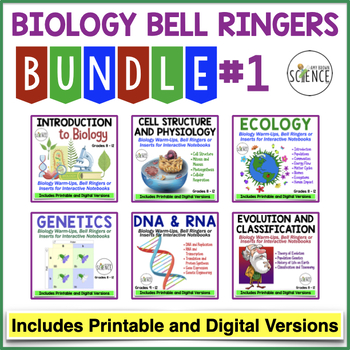Cells, Genetics, DNA and RNA, Ecology, Evolution Bell Ringers Bundle
- Zip
- Google Apps™

What educators are saying
Products in this Bundle (6)
showing 1-5 of 6 products
Bonus
Also included in
- This resource consists of ONE FULL YEAR of Biology No Prep Warm Ups, Bell Ringers, and Inserts for Interactive Notebooks. This is a huge bundle of 35 sets of warm ups and bell ringers covering all chapters in a typical biology textbook:Introduction to ScienceCell Structure and FunctionEcologyGenetiPrice $182.00Original Price $254.63Save $72.63
Description
This resource is a set of 300+ Warm-Ups, Bell-Ringers, or Exit Slips for 6 different units of study. This bundle covers: Introduction to science, cell structure and function, photosynthesis, respiration, cell division, ecology, genetics, DNA, RNA, protein synthesis, evolution, population genetics, the history of life on Earth, and classification. These activities are perfect for the first few minutes of your class. Both printable and digital versions are included.
This bundle includes the following 6 sets of my best-selling warm ups:
- Introduction to Science Warm Ups and Bell Ringers
- Cell Structure, Function, and Physiology Warm Ups and Bell Ringers
- Ecology Warm Ups and Bell Ringers
- Genetics Warm Ups and Bell Ringers
- DNA, RNA and Protein Synthesis Warm Ups and Bell Ringers
- Evolution and Classification Warm Ups
Both printable and digital versions are included. The student handouts can be printed or used in the paperless digital format in your Google Drive, Google Classroom, Microsoft OneDrive, or similar. This resource is perfect for traditional classroom settings, 1:1 schools, or for distance learning.
Included in this resource:
- 300+ Printable and Editable warm-up or bell-ringer activities
- Digital paperless versions (not editable) for use in Google Drive, Google Classroom, and/or Microsoft OneDrive
- Complete answer keys
- Teacher Guide for Warm Ups
- Teacher Guide for Google Apps
- Editable Template pages for starting a warm-up interactive notebook (title page, table of contents)
- Editable Template for creating your own warm-ups.
How can these be used?
- Warm Ups or Bell Ringers
- Exit Slips
- Additions to Interactive Notebooks
- Homework Assignments
- Tutoring and Review
- Short daily quizzes
- Completed notebook is perfect for semester exam review.
Try before you buy! Click here to download a free sample of my warm ups, bell ringers, and interactive notebook pages. The sampler includes pages from all of my warm up units.
Classroom management is a very large part of what we do every day as science teachers, and the first few minutes of a class period can be somewhat chaotic. You can turn this chaotic time at the beginning of your class into an organized time of meaningful learning.
Please Note: These warm-ups are designed to take 5-7 minutes to complete. They are used for review and reinforcement of key concepts, but are not intended to be used as first-time instruction. Students will need prior instruction and/or textbook to complete these warm ups. This resource contains pages that can be used as warm ups, bell ringers, inserts for your interactive notebooks, homework assignments, or classwork.
This resource does not include teaching materials such as textbook readings, informational text readings, or a teaching PowerPoint.
The pages are printed landscape style. The pages look best if printed in color, but also look great if printed in black/white. Each activity is one-half page in size. Two identical warm-ups are printed per page in order to conserve paper. These half-page activities can be collected and quickly graded, or you might want to have your students keep a daily warm-up notebook. These warm-ups will make excellent additions to your interactive notebooks.
In this time saving classroom management strategy, all you have to do is print the pages, cut them in half and put your students to work.
Related Products Include:
Introduction to Biology Complete Unit Plan Bundle
The Ultimate Microscope Teaching Bundle
Biochemistry Complete Unit Plan Bundle
Cell Structure and Function Complete Unit Plan Bundle
Mitosis and Meiosis Complete Unit Plan Bundle
Enzymes and the Chemical Reactions of the Cell Complete Unit Plan Bundle
Photosynthesis Complete Unit Plan Bundle
Cellular Respiration Complete Unit Plan Bundle
DNA, RNA, and Protein Synthesis Complete Unit Plan Bundle
Genetics Complete Unit Plan Bundle
Classification and Taxonomy Complete Unit Plan Bundle
Introduction to Ecology Complete Unit Plan Bundle
Population Ecology Complete Unit Plan Bundle
Community Ecology Complete Unit Plan Bundle
For updates about sales and new products, please follow my store:






